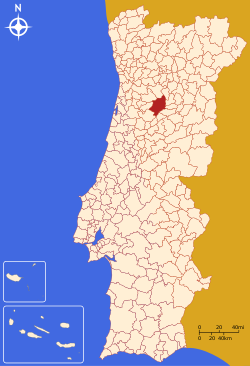Viseu
| Viseu | |||
|---|---|---|---|
| Municipality | |||

Panoramic view of Viseu.
|
|||
|
|||
 |
|||
| Coordinates: 40°40′N 7°55′W / 40.667°N 7.917°WCoordinates: 40°40′N 7°55′W / 40.667°N 7.917°W | |||
| Country |
|
||
| Region | Centro | ||
| Subregion | Dão-Lafões | ||
| Intermunic. comm. | Viseu Dão Lafões | ||
| District | Viseu | ||
| Parishes | 25 | ||
| Government | |||
| • President | Almeida Henriques (PSD) | ||
| Area | |||
| • Total | 507.10 km2 (195.79 sq mi) | ||
| Population (2011) | |||
| • Total | 99,274 | ||
| • Density | 200/km2 (510/sq mi) | ||
| Time zone | WET/WEST (UTC+0/+1) | ||
| Website | http://www.cm-viseu.pt/ | ||
Viseu (Portuguese pronunciation: [viˈzew]) is a city and municipality in the Centro Region of Portugal and the capital of the district of the same name, with a population of 99,274 inhabitants, and center of the Viseu Dão Lafões intermunipical community, with 267,633 inhabitants.
Settled during the period of the early Iberian castro culture, the territory of Viseu was populated by a series of cultures, that include the Romans, Suebs, Visigoths and Moors. During the Roman occupation of Iberia, Viriathus, rebel leader of the Lusitanians, is assumed to have lived for a time in territory. During the Middle Ages, the city often served as seat for Visigothic nobles (such as King Roderic), and is considered one of the probable birthplaces of Afonso Henriques, first King of Portugal.
Viseu is a regional economic hub with a strong wine industry and is the seat of international conglomerate Visabeira. Similarly, the city is a cultural center, home to the nationally-acclaimed Grão Vasco Museum, seat of the Roman Catholic Diocese of Viseu, and pole of national universities, including the Catholic University of Portugal.
The origins of the city of Viseu date back to the Celtic period. With its Romanization, the settlement gained importance, being at the intersection of a series of Roman roads linking Mérida, Lisbon, and Galicia.
...
Wikipedia


